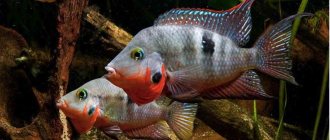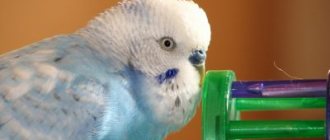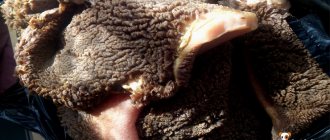Duration and lifestyle
In the wild, representatives of the species have an average life expectancy of up to 5 years. This indicator is negatively affected by:
- Diseases.
- Human disturbance of their natural habitat.
- Poaching.
- Activities of natural predators.
- Harsh living conditions.
At home, due to the careful care and care of the owner, finches can live much longer.
Most species prefer to settle in steppe flat areas. Some prefer forests in which they settle on the edges. Sometimes they can be found in semi-deserts.
The basis of their natural diet is food of plant origin, primarily seeds of various plants. Sometimes you don’t even mind pampering yourself with products of animal origin, such as insect larvae.
They belong to the category of songbirds. Moreover, the song of most species is quiet, but melodious.
It's not just males who sing. Sometimes females can do this too.
Zebra finches
The zebra finch got its name due to the alternating light and dark stripes in the chest area, on the neck, and white stripes on the tail.
The zebra finch has a body length of ten centimeters. There are two varieties of this species. The mainland one lives in Australia, the island one has chosen the Lesser Sunda Islands.
These birds can be found both in arid areas, on the outskirts of forests, in the steppes, and near human settlements. Zebra finches are not afraid of people; they can live in their sight: on the street, in the yard, in the garden.
In nature, birds of this species gather in large flocks and collectively search for food and water. Birds fly away only at night. The zebra finch has developed resistance to dehydration after living in arid areas. Birds can live for months without water and drink water with high salt content, which is lethal to other birds.
Birds are ready for breeding after the end of the first molt - at three to five months. Zebra nesting depends on the amount and frequency of rainfall. If they travel long and often in the area chosen for their residence, the birds will nest annually, laying up to four clutches per season. If finches live in a dry region where rain is very rare, then they can wait several years for the right time to nest.
To build nests, the zebra species chooses groves of acacias or thorny bushes, and tree hollows. Such places protect the masonry from attacks by snakes or lizards. By the nesting period, birds flock together in pairs, forming small communities. Several pairs can nest on one bush or tree at the same time.
Parents sing peculiar trill songs to their chicks. Chicks remember melodies, even during sleep their brain works in this direction. As adults, zebra finches sing their parents' songs to their chicks.
The zebra finch gained fame at the end of the nineteenth century. Thanks to selection, fawn, crested, black and white, and white finches of this species were obtained. There have been attempts at hybridization with other weaver species. However, the bulk of the hybrids turned out to be sterile.
Character
In captivity, their character manifests itself somewhat ambiguously. On the one hand, they are distinguished by trust in their owner. But on the other hand, finches of many species really don’t like it when the owner or another person picks them up.
Unlike most other pets, they can tolerate the absence of their owner for several days relatively calmly, provided they have enough food and drink. They can be kept as a pet by people who often go on long business trips, or simply by people who are very busy at work.
One student and complete isolation
One of the important requirements in taming finches is that you only need to work with one bird. Of course, you can tame several birds, but take turns. Even two pets will become distracted by each other and panic together at your movements, let alone more birds.
Before you start training, isolate the finch from its brethren for the entire training period. The cage in which the bird will live at this time should be small in size. It is desirable that the top fold down or the front wall opens completely. Thanks to this design, it is more convenient to catch the pet or carry it out of the cage on your hand.
Varieties
Scientists count 38 species and more than 300 subspecies. Their number grows every year. This is explained by the activities of breeders who are constantly developing new varieties of these birds. We will look at some varieties popular among poultry farmers. In our article we will not touch upon such types as:
Amadina Gulda.
Zebra.
Rice.
Japanese
This variety was bred by breeders from the Land of the Rising Sun and from there came to Europe. Its representatives live mainly in conditions of captivity. In natural conditions, you can sometimes find feral individuals. Thanks to their calm nature and unpretentiousness, even inexperienced amateurs can successfully breed them. They tolerate being kept with other non-aggressive birds quite calmly.
Chinese sparrows
They live in China and some parts of India. They are distinguished by their loudness and ability to make many different sounds. At home they can be kept together with other birds. Despite this, they are rare in captivity.
Diamond
They live in the wild in Australia. In their natural environment, they prefer to settle in low eucalyptus groves and forests. They cannot tolerate dense forests. Life expectancy is up to 5-7 years. Quite often found among home hobbyists.
Sharp-tailed
Sharp-tailed finches live in northern Australia. This is the largest bird of the order - its length reaches 17 cm, and its weight is 17.6 g. Since the end of the 19th century, the keeping of this bird in home cages and aviaries has been recorded. They are one of the favorite bird species among amateur birders.
Parrot finches
Representatives of this genus live over a vast territory of Southeast Asia, the Pacific Islands and northern Australia. The color of most species is dominated by green shades interspersed with areas of blue and red. They prefer to settle in the jungle, bamboo groves, and meadow areas. Often found at home.
Red-throated
Habitat: southern and southwestern Africa. The species gets its name from the red plumage on its throat and head. The wings and body of the birds are brown. Belongs to the smallest representatives of the family. The maximum body length reaches 13 cm.
Chestnut-breasted
Lives in Guinea, northern and eastern Australia. It got its name due to the light brown color of the breast. Prefers to live in large flocks in the jungle near water sources. Quite often found at home.
Scaly-breasted
Under natural conditions, this bird can be found in China, India, Indonesia, and the Philippines. Prefers to live in large flocks in tropical forests. It got its name because of its gray-brown color with a characteristic scaly pattern.
The history of finches in cages
Each cell must have:
- Broom and dustpan for cleaning;
- Nesting devices - when kept in pairs;
- Container for water procedures;
- Minimum 2 perches;
- Container for mineral feed;
- Drinking bowl;
- At least 2 feeders (for grain mixture and for additional feed).
The perches should have a diameter of approximately 0.9 cm and are made of hard wood. Basically, only 2 perches are installed at the maximum distance from each other. This is due to the fact that the bird needs to fly at least a little. When installing the perch, remember that the bird’s tail should not come into contact with the rods. To prevent the growth of claws on the paws, the perches are smeared with clay or glued with sandpaper.
Materials for bedding are:
- newsprint, cut into pieces,
- small wood shavings,
- sawdust.
Having prepared all the necessary conditions for the care and maintenance of finches, you can safely release them into the cage.
Finches are miniature birds that belong to the weaver finches family. There are more than 30 species of them in the world. These are heat-loving creatures, so they live mainly in Africa, Australia and Southeast Asia.
The Japanese finch was the first to be domesticated. This happened more than 400 years ago, as mentioned in historical materials. These birds appeared on the European continent much later, in the 18th century.
Interesting fact: the Japanese finch can be an excellent nanny for the chicks of other species, so they were often kept for this very purpose. Their ancestors lived on the Philippine Islands, from where they came to Japan and China.
At the same time as the Japanese birds, rice finches also found themselves in cages. They were discovered on the islands of Java and Sumatra, and later they spread to Southeast Asia.
Zebra finches and Gould's finches are native to Australia. The former often settle near human habitation, are not afraid of noise and are accustomed to being close to people. Data on keeping these birds in captivity date back to the second half of the 19th century. And in the twentieth century, zebra finches were already widely known in Western Europe.
Gould's finches were discovered by British naturalist John Gould in 1838-1840 during his travels in Australia. This species was named in honor of his wife Elizabeth, who accompanied her husband on the trip, but soon died. They were brought to Europe in 1887-1915.
How to distinguish a female from a male
There are several ways to distinguish a male from a female by appearance. Each of them requires separate mention.
By the beak
Males have larger beaks and are usually more brightly and deeply colored than females.
By color
The characteristic color characteristics of males and females differ in different species of finches. For example, male red-headed finches have a red head, which distinguishes them from females. The male zebra finch is gray but has a brown and white marking on the neck. They have a zebra pattern on their chest in the form of alternating white and black stripes. The color of the females is different from the color of the males.
By singing
Representatives of the stronger sex usually sing much better than females. Males do this beautifully and for a long time, sometimes performing complex compositions. The sounds made by females are usually abrupt and quiet. This can hardly be called singing at all. So if an individual sings well, it is almost certainly a male.
The owner must decide for himself how to distinguish a male from a female. It is advisable to use more than one method.
Rice finches
The rice finch is a small bird fourteen centimeters long. The upper part of the bird's body is painted gray, with a barely noticeable steel tint. The belly is light pink, the head is black, with white cheeks. The black tail has white feathers. The massive beak stands out due to its deep red hue. Closer to the base it darkens. Pinkish eyelids are also noticeable.
Initially, the pancake lived in Indochina and southern China. It could also be found in the west of the Malaysian Islands. The species later spread to southeast Asia and eastern Africa.
White creatures have been bred that are not considered albinos due to their black eyes. There is also a variegated, blue, light beige, marbled rice variety. However, birds with naturally colored feathers remained the most popular.
The special feature of the drawings is a cheerful song that sounds like bells.
Keeping at home
In captivity, keeping these birds is quite simple, you just need to try to follow some rules.
Selecting a cage and accessories
The length and width of the cage must be at least 0.5 meters. It is important that it is tall and has the correct rectangular and square shape. In rounded cages, finches get lost and become stressed. The owner must equip the living area with perches and a sippy cup.
Light mode
The optimal length of daylight for birds is 12-13 hours every day. It is quite possible to provide it at home. The owner will need:
Place the cage in the brightest room.
In autumn, winter and early spring, provide additional lighting with special lamps.
It is highly desirable that the cage receives direct sunlight for 3 hours a day. Such sunbathing is beneficial for pets. In a private house, during the warm season, the owner can take the cage out into the yard and place it in partial shade.
Diet planning
It is desirable that the food for finches be as close to natural as possible. Therefore, the basis of bird nutrition should be grain mixtures. They need to include:
Millet.
Wheat and corn chaff.
Millet.
Sunflower seeds.
Millet is considered the most useful grain for finches. In addition to grain, finches readily eat vegetables and fruits. Among the vegetables, onions and dill are unconditionally prohibited. But cabbage of all kinds, beets, carrots, cucumbers and pumpkin can and should be given. Among fruits, tangerine will be very useful. You can give dairy products.
Education and domestication
Raising and taming a finch is a long and strictly individual process. It will not be possible to work with two birds at the same time. First, you need to place the tamed pet in a separate small cage. Its design should allow the owner to quickly and conveniently retrieve the bird.
Before starting the training cycle, your pet’s wings need to be trimmed slightly. The entire process should take place in a room with the windows and door closed. This will help avoid accidental troubles during training. At the first stage, you need to train the bird to sit on the owner’s hand. To do this, you need to drive the bird into the corner of the cage so that it cannot escape anywhere except the owner's hand.
After she gets used to doing this, we must try to accustom her to being with her owner outside the cage. To do this, you need to take the finch sitting on your hand out of the cage and do this regularly, every day. In order for the bird to get used to being outside the cage, the owner is recommended to keep it on his shoulder for some time every day. It is advisable to equip a play corner in the room in which the bird can spend time when it is outside the cage. If, when the owner approaches, the bird begins to ask to be released, this means that the process of education and taming is completed.
At the first stage, you need to train the bird to sit on the owner’s hand.
After she gets used to doing this, we must try to accustom her to being with her owner outside the cage.
Bathing
Finches bathe without the help of their owner and with great pleasure. They independently jump into the bath, wash themselves there and move to a perch, where they rest and clean their feathers, not only for themselves, but also for each other.
Swimsuits can be floor-mounted or hanging. The latter are preferable, as they are more comfortable for birds and cause less water splashing.
It should be at room temperature, preferably filtered or bottled.
Care during shedding
Molting lasts from 2 weeks to a month. For many birds it is painless, but some still experience difficulties. The appearance deteriorates, the birds become less mobile, the males stop singing. The temperature may rise and appetite may decrease.
The main care during molting is feeding. Birds need to be given:
Sprouted wheat.
Food of animal origin (dairy products).
Fresh greens.
Reproduction at home
Passerines quite successfully give birth to offspring at home.
To encourage the couple to continue their race, the owner needs to equip the cage with a nesting house.
How long do eggs hatch?
The duration of the process is approximately 12 days. Both male and female take part in incubation. The female spends more time on the eggs.
It is noted that the chicks do not hatch from all the eggs, the number of which in a clutch can be from 3 to 6. Sometimes birds peck at the eggs themselves. This phenomenon is caused by a lack of nutrition. Therefore, the birds’ food during mating and brooding should be rich in protein and microelements.
Features of caring for chicks
Parents feed the chicks until they are 3-4 weeks old. At this age, the offspring leaves the parental nest. The owner must constantly monitor how the parents care for the chicks. If necessary, you need to feed them yourself.
To make it convenient for young birds to explore the space of the cage, the owner needs to equip it with additional perches.
The water level in drinking bowls and bathing basins must be lowered so that young birds do not drown.
Diseases and prevention
The range of diseases affecting finches is quite extensive and difficult to cover in a short article. It is only necessary to clearly state that proper care is the basis for disease prevention. Each newly purchased bird must be quarantined in a separate cage. At the slightest sign of discomfort - lethargy, passivity, weight loss, you should contact a veterinarian.










